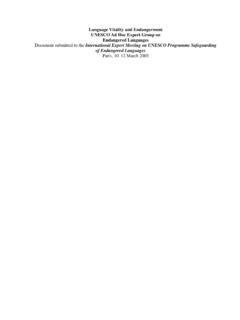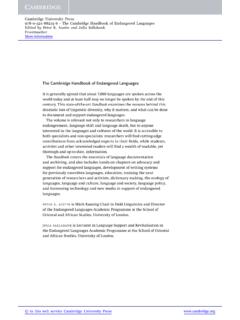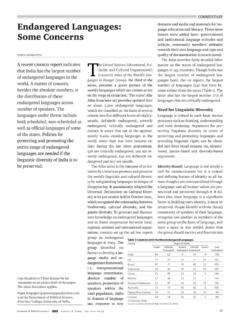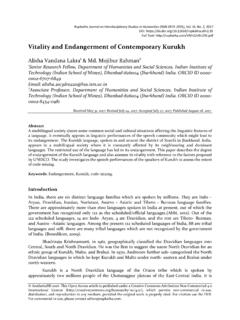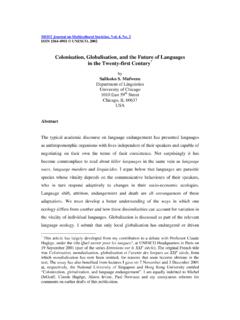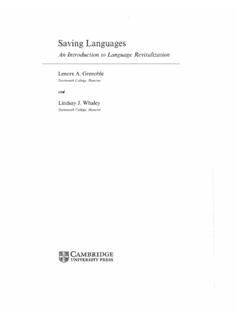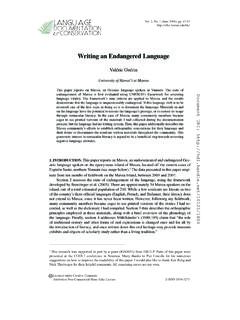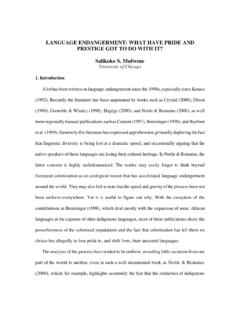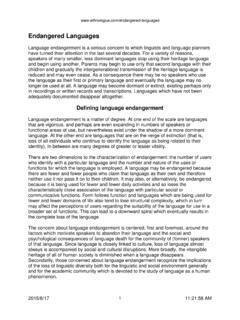Transcription of Documenting Endangered Languages And Maintaining …
1 UNESCO EOLSSSAMPLE CHAPTERSLINGUISTIC ANTHROPOLOGY Documenting Endangered Languages and Maintaining language Diversity - Matthias Brenzinger, Tjeerd de Graaf Encyclopedia of Life Support Systems (EOLSS) Documenting Endangered Languages AND Maintaining language DIVERSITY Matthias Brenzinger Research Institute for Languages and Cultures of Asia and Africa, Tokyo University of Foreign Studies, Japan Tjeerd de Graaf Slavic Research Center, Hokkaido University, Japan and Frisian Academy, the Netherlands Keywords: Endangered Languages , ethnolinguistics, language documentation, language endangerment, language maintenance, language policy, language revitalization, language shift, mother tongue education. Contents 1. Introduction 2. language Endangerment and Endangered Languages Types and Extent of language Endangerment Selected Case Studies of Endangered Languages /Xam, a Case of Physical and Cultural Genocide in South Africa Ainu in Japan Nivkh in the Russian Federation North Frisian in Germany Amazigh (Berber) Languages in Northern Africa 3.
2 language Documentation Why Study Endangered Languages ? Documenting Endangered Languages Assessing language Vitality and Endangerment language Maintenance and Revitalization 4. Concluding Remarks Acknowledgments Glossary Bibliography Biographical Sketches Summary Several scholars predict that up to 90% of the world s Languages may well be replaced by dominant Languages by the end of the twenty-first century, which would reduce the present number of almost 7000 Languages to about 700. This review article attempts to describe processes that are underlying this severe threat to the majority of the Languages currently spoken. However, the central focus of discussion will be on aspects related to the documentation and maintenance of the world s linguistic diversity.
3 The main causes of language endangerment are presented here in a brief overview of the world s language situation. Selected studies on Endangered Languages provide insight UNESCO EOLSSSAMPLE CHAPTERSLINGUISTIC ANTHROPOLOGY Documenting Endangered Languages and Maintaining language Diversity - Matthias Brenzinger, Tjeerd de Graaf Encyclopedia of Life Support Systems (EOLSS) into the case-specific aspects of these language shift situations. Finally, language documentation and maintenance efforts of scholars, international institutions, such as provided within the framework of UNESCO, as well as the role of academic cooperation in recent language documentation activities, will be discussed. The fundamental task for linguists is research on the collection of data from Endangered Languages .
4 Linguistics may preserve language data in Documenting Languages . However, it is the members of the speech communities that either uphold or give up Languages . Only the speakers of Endangered Languages themselves can opt for and execute language maintenance or revitalization measures. Linguists and other scholars can assist communities in such attempts, for example by making language resources from archives available to them, by training community members to become language workers or even linguists, and also by helping to produce language learning and teaching materials. Linguists and community members should together take on the responsibility for Documenting the wealth of linguistic diversity in order to pass on this legacy to future generations.
5 1. Introduction In his article Who am I in this land? What people am I part of? Sergey Haruchi, representative of one of the minority peoples in the Russian North, gives the following account on his relation to the Nenets people and their language : I experienced no shock on realising that I belonged to the Nenets people. Everything was formed during my childhood; both my father and my mother spoke Nenets. They did so without embarrassment, even in the presence of strangers. Regretfully, though, the environment in which children now find themselves for the greater part of their time, at kindergarten, at school, has had an impact. They talk with their parents only in the mornings and the evenings. As a consequence, some children of indigenous intellectuals, not only from families of mixed marriages but even those whose fathers and mothers are both Nenets, do not know their native language .
6 My own eldest daughter and son understand but do not speak Nenets, because they have no opportunity to practise it. I am not trying to use this as a reason to excuse myself. It is our fault and nobody else s. Nevertheless, there are still children who know their native Languages well and speak it fluently. When a cry of lamentation is raised that the language , the basis of the people's culture, is sinking into oblivion and that books and textbooks should be published in native Languages , I do not object to this; I even support it and assist to the best of my ability. But, after all, our parents did not teach us their native language by using books, we learned by hearing our mothers talk to us. It is first and foremost the mother who passes on the language , and a great deal depends on her because she spends more time with the children.
7 It makes me wonder if it is right to put the blame for our children not speaking their native language on other people, for example, the Russian people, who allegedly impose their language on us. First and foremost, we must have strong desire to pass on the language . Our children ought to speak their native language . UNESCO EOLSSSAMPLE CHAPTERSLINGUISTIC ANTHROPOLOGY Documenting Endangered Languages and Maintaining language Diversity - Matthias Brenzinger, Tjeerd de Graaf Encyclopedia of Life Support Systems (EOLSS) This quote illustrates what can be considered to be the situation of minority Languages in the Russian North, where, just as in many other parts of the world, the local Languages are increasingly dominated and threatened by the official state Languages , such as Russian in the case above.
8 At the 31st Session of the UNESCO General Conference (October 2001), the unanimously adopted Universal Declaration on Cultural Diversity recognized a relationship between biodiversity, cultural diversity, and linguistic diversity. UNESCO s action plan recommends that Member States, in conjunction with speaker communities, undertake steps to ensure: sustaining the linguistic diversity of humanity and giving support to expression, creation, and dissemination of the greatest possible number of Languages ; encouraging linguistic diversity at all levels of education, wherever possible, and fostering the learning of several Languages from the youngest age; incorporating, where appropriate, traditional pedagogies into the education process with a view to preserving and making full use of culturally-appropriate methods of communication and transmission of knowledge.
9 And where permitted by speaker communities, encouraging universal access to information in the public domain through the global network, including promoting linguistic diversity in cyberspace. 2. language Endangerment and Endangered Languages A language is in danger when its speakers no longer pass it onto the next generation. Today, many speech communities of minority Languages are shrinking and their Languages will ultimately vanish, if these developments are not reversed. Children may no longer acquire Languages even when they are still spoken by many thousands of elderly speakers. Types and Extent of language Endangerment language endangerment may be caused primarily by external forces such as military, economic, religious, cultural, or educational subjugation.
10 It may also be caused by internal forces, such as a community s negative attitude towards its own language or by a general decline of group identity. Internal pressures always derive from external factors. Together, they halt the intergenerational transmission of linguistic and cultural traditions. Many minority communities associate their disadvantaged social and economic position with their ancestral culture and language . They have come to believe that their Languages are of no use anymore and not worth retaining. Speakers of minority Languages abandon their Languages and cultures in the hope of overcoming discrimination, to secure a livelihood and enhance social mobility for themselves and their children. Endangered Languages are not necessarily Languages with few speakers.










